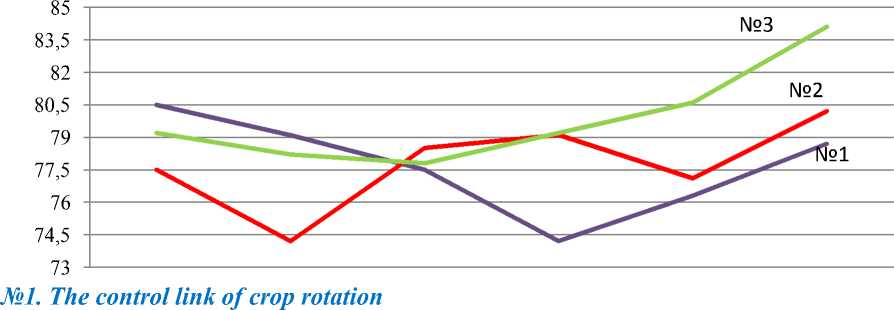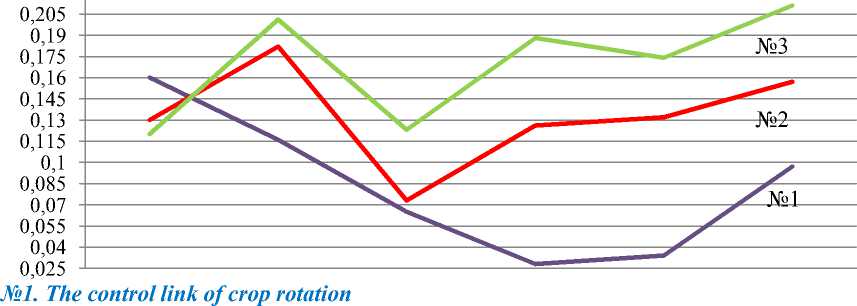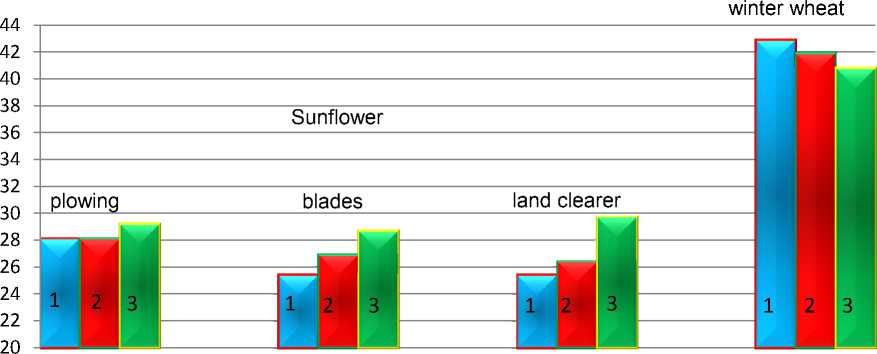Role of binary sowing crops with legumes for preserving and improving soil fertility
Автор: Nesmeyanova M.A., Kuznetsova T.G., Dedov A.V.
Журнал: Вестник аграрной науки @vestnikogau
Статья в выпуске: 6 (45), 2013 года.
Бесплатный доступ
The article presents research results of the Agriculture Department of Voronezh State Agricultural University on cultivating legumes in binary crops with sunflower and winter wheat in conjunction with using green manure crops. The effect of the studied factors on fertility of black soil and crop yields is shown.
Fertility, structure, water resistance, organic matter, productivity
Короткий адрес: https://sciup.org/147124129
IDR: 147124129 | УДК: 631.45:631.153.3:651.95
Текст научной статьи Role of binary sowing crops with legumes for preserving and improving soil fertility
In Central Black Earth Region (CBER), fertility of black soils is decreased under intensive development of agriculture in recent years. The pursuit of high profits that implied minimal costs having not been substantiated scientifically has been affecting negatively the basic properties and regimes of black earth. On many farms, nutrients do not return to the soil with organic and mineral fertilizers, which is immediately reflected on the value of productivity and agricultural production profitability.
In our opinion, the current situation can be radically changed by means introduction of perennial legumes (namely blue alfalfa and yellow sweet clover) in crop rotations as both binary components and fallow cultures against the background of using cereal straw and stubble green manuring.
In this regard, the purpose of our experiment was to study the influence of complex biological techniques for restoring soil fertility (e.g. cereal straw, stubble green manuring, binary crops with legumes, green manure fallowing) and tillage on the indicators of black earth fertility and crop rotation links productivity.
Experimental plot soil is typical clayey black earth, humus content in the topsoil 5.4 %, pH 5.4, the amount of exchangeable bases - 34, content of available phosphorus and potassium is 113 and 184 mg / kg.
Years of research 2010 and 2011 were slightly dry (hydrothermal coefficient = 1.0), and 2012 - excessively wet (hydrothermal coefficient = 1.6). Experiment laid out in accordance with the common method of field experiments. Placement cultures were systematic, repeated three times. The links of crop rotation represented by all fields in space. Plot square - 525 m2.
Crop rotation link number 1 (control): fallow - winter wheat - barley - sunflower (control -plowing). Crop rotation link number 2: sweet clover sidereal fallow - winter wheat - barley -binary sowing sunflower with yellow sweet clover (on stubble green manure (white radish and mustard)). Link Crop rotation link number 3: occupied fallow (blue alfalfa) - binary sowing winter wheat with blue alfalfa - barley - binary planting sunflowers with blue alfalfa (on stubble green manure (white radish and mustard)). Variants of basic soil tillage for sunflower: plowing – 20 - 22 cm, blades – 10 - 12 cm, land clearer 20 - 22 cm.
Sampling and observations were made 3 times: 1st - sprouting crops, the spring growth of grasses in fallow fields, 2nd - bloom; 3rd - full maturity crops, in fallow fields - before the sowing of winter wheat.
Studies have shown that the use of legumes (e.g. blue alfalfa and yellow sweet clover) helped to preserve and improve soil fertility, which resulted in a major improvement of agro and biological soil properties and increase crop yields.
According to the results of research, the use of blue alfalfa and yellow sweet clover in the links of crop rotation with binary sowing accompanied by an improvement of the structural condition of the soil. If in the first year of blue alfalfa life as a binary component of sunflower observed only a relatively small reduction in the rate of structure (4 - 15% depending on stubble green manure and tillage), then in the second year of life in a fallow field (Fig. 1) the number of agronomically valuable aggregates in the soil layer increased, which resulted in the growth of the average coefficient of structure by 20%.
The increase of structure coefficient (by 26.7%) is observed in the third year of alfalfa life in a binary sowing with winter wheat. As a result, during the three years of blue alfalfa cultivation in the study link of crop rotation structure coefficient increase was 52% and its average index was 2.40.
During the first year of yellow sweet clover cultivation in binary sowing with sunflower observed decrease of structure coefficient by 7 – 17% in the soil layer 0 - 30 cm (in the control variant drop of this index was 26%), and then, structure coefficient increased by 14% during the second year in the yellow sweet clover fallow field. In contrast, winter wheat cultivation on fallow green manure (yellow sweet clover) entailed decrease of the structure coefficient by 5.2% in topsoil. As a result, in this link of crop rotation structure coefficient has increased an average only by 8.3%, while the average index was 2.19 for three years.
In the control link of crop rotation for the considered period there was a decrease of structure factor by 17.9%, and its average value was 1.80.
Figure 1 - Dynamics of structure coefficient in crop rotation links (soil layer 0-30 cm, 2010-2012)

№1. The control link of crop rotation
№2. Link of crop rotation with yellow sweet clover
№3. Link of crop rotation with blue alfalfa
In addition to improving soil structure, studied legumes had a positive effect on water stability of soil aggregates (Fig. 2).
Under the single-species planting sunflowers the amount of water-stable aggregates in topsoil decreased by 2.4%, while in binary sowing with blue alfalfa reduction of water-stable aggregates ranged from 0.8% to 3.9% during the first year (depending on stubble green manure and tillage).
The second year of blue alfalfa cultivation in occupied fallow contributed to increase water resistance of soil by 1.7%, whereas on the control plot the amount of water-stable aggregates decreased by 4.3% at the same time.
In the variant of binary sowing winter wheat with third year blue alfalfa is marked further increase of the water-resistant structure by 4.8%. Over years of research, the dynamics of water-resistant structure of topsoil in the link of crop rotation with blue alfalfa increased by 6.7%, and the average value was 79.8% on average.
At sunflower harvest, in crop rotation link with yellow sweet clover originally observed reduction of water-stable aggregates, which ranged from 0.3 to 2.4%, further growing of sweet clover in green manure fallow accompanied by an increase of water-stable aggregates by 2.1%.
Figure 2 - Dynamics of soil water resistance in various crop rotation links, % (soil layer 0-30 cm, years 2010-2012)

№2. Link of crop rotation with yellow sweet clover
№3. Link of crop rotation with blue alfalfa
Figure 3 - Dynamics of detritus in various crop rotation links, % (soil layer 0-30 cm, years 2010-2012)

№2. Link of crop rotation with yellow sweet clover №3. Link of crop rotation with blue alfalfa
But the cultivation of winter wheat on green manure fallow with yellow sweet clover did not improve the water resistance of soil and the figure was 78.7% on average during vegetation period. As a result, the dynamics of soil water resistance in the link of crop rotation with yellow sweet clover was 2.1%, and its mean value - 78.2% for the period of studies.
Within the research also found a significant effect of the studied factors on the content of the soil detritus (Fig. 3).
If in control link of crop rotation there is a decrease of soil detritus content (52.9%) by the end of the three-year study period, then the link of crop rotation with blue alfalfa characterized by increase soil detritus content throughout the period of cultivation for all the studied cultures.
Thus, binary sowing sunflowers with blue alfalfa increases content of the soil detritus in 1.13 – 2.22 times depending on stubble green manure and tillage. A further increase of the soil detritus content observed in the occupied fallow (1.53 times) and binary sowing winter wheat (1.21 times). By the end of the study period its content in topsoil increased by 20%, bringing the average value of 0.169.
Figure 4 - D y n am ic s of mobile phosphorus in various crop rotation link s, m g / k g (soil layer 0-30 cm, years 2010-2012)

№2. Link of crop rotation with yellow sweet clover №3. Link of crop rotation with blue alfalfa
T he inf lu e n ce of s tu d ie d fa ctor s o n th e n u t r ie n t st a tu s of th e so il is e x p r e s se d in the r a tio na l co n sum p tio n of m a j or n u t r ie n ts ( Fi g. 4 an d 5 ) . Using , f or e x a m p le , b lu e a l f a l f a w ith sunflower in binary sowing accompanied not only more ratio n a l co nsu m p tio n of macronutrients, but the increase of their contents in the soil. T h u s, in th e v a r ia n t w ith r a d ish increasing the amount of movable phosphorus ranged from 0.7 to 6.9% and the exchange potassium from 6 to 18%, whereas in the control vari a n t o bs erv e d r e d uct ion of t he s e elements by 11.3% and 4.4% respectively. By the time of w int er w he a t sowing in the occ u pie d fa llo w with b lue a lf a l f a c onsu m ptio n of m o b ile p h o sp h o r u s w as 4 7 %, a n d m o b ile potassium - 12.1%, which is less than consumption of these elements in the variant of pure fallow on 25 and 27.7% respectively.
Binary sowing of winter whea t with b lu e a lf a l f a is a lso ch a r a c te r iz e d b y a low e r con s um ptio n o f m a cr o n utr ie n ts : 5 4 .3% of a v a ila bl e p h o sp h o r u s a n d 4 2 .3 % of e x ch a n ge a b l e po ta ssiu m, w h ich is le s s th an i n the ca s e w ith co ntr o l s ow in g of w in te r w h e a t b y 8 .4 a n d 3%.
Studied factors had a n und e n ia b le im p a ct o n th e y ield of c r o p s ( Fi g . 6 ).
Figure 5 - Dynamics of exchangeable potassium i n v arious crop rot at ion link s, mg / kg (soil layer 0-30 cm, years 2010-2012)

№2. Link of crop rotation with yellow sweet clover №3. Link of crop rotation with blue alfalfa
Figure 6 - Crop y iel ds w it hin t he v arious link s of crop rot at ion, c/ ha (years 2010-2012)

№1. The control link of crop rotation
№2. Link of crop rotation with yellow sweet clover
№3. Link of crop rotation with blue alfalfa
T h u s , th e y ie ld o f su nf low e r in b in a r y sow in g w it h b lu e a l f a l f a w a s h igh er th a n th e y ie ld of control single-sp e cie s so win g, f o r a ll th e o p tio ns o f so il t r e atme nt a n d stu b b le gr e e n manuring. Its value ranged from 28.4 to 30.4 c/ha which ge n e r a lly exceed e d th e co n t r o l value by 1.1 – 8.2 % (Table 8). S ign i f ica ntly h ighe r y ie ld of s unf lo w e r w a s o b ta in e d in o ptio n with binary sowing blue alfalfa after radish during plowing (1. 9 c / h a) a n d d u r in g la n d clearing (2.3 c / ha).
Yield of winter wheat in binary sowing was below control v a lu e a n d am o u n te d 4 0 .8 c/ha.
T h u s , th e u se of b lu e a l fa lf a in b in a r y so w in g w it h w in te r w h e a t a n d su nf l o w e r , a s w e ll as fallow culture, in complex with other bio lo gi c al te ch ni q u es fo r restor in g so il f ertili ty (e.g. straw and green manure crops), ensure the pre se r v a tio n a n d im p r o v e m e n t of so il f er tility , which is expressed by the improvement of soil structu r e a nd w a te r r e sistan ce, by increasing content of the soil detritus and by rising crop yields.
Список литературы Role of binary sowing crops with legumes for preserving and improving soil fertility
- Garmashov, V.M. About minimize basic soil tillage under sunflower in Central Black Earth State Biosphere Reserve/V.M. Garmashov//Cereal farming, № 2. -2006. -P. 9 -11
- Dedov, A.V. Soil organic matter and its regulation in the Central Black Earth Region/A.V. Dedov. -Voronezh: VSAU, 1999. -202 p
- Dedov, A.V. Complex biological techniques for restoring black earth fertility/A.V. Dedov, M.A. Nesmeyanova, N.N. Khryukin//Agriculture, № 6. -2012. -P. 4 -7
- Dedov, A.V. Effect of perennial grasses on soil fertility/A.V. Dedov, M.A. Nesmeyanova.//Agrochemical vestnik, № 4. -2012. -P. 7 -9
- Zezyukov, N.I. Influence of green manure crops on agro indicators of soil fertility, crop yields and crop clogging/N.I. Zezyukov, A.V. Dedov, N.I. Pridvorev, V.A. Maslov/Black Earth 2000: status and prospects of rational use/collection of proceedings/Voronezh, 2000. -340 p
- Lugantsev, E.P. Binary sowing of sunflower and legumes for preserving soil fertility/E.P. Lugantsev, A.P. Avdeenko, N.A. Zelenskiy, I.N. Shestov//Zemledelie. -№ 4. -2008. -P. 22 -23


